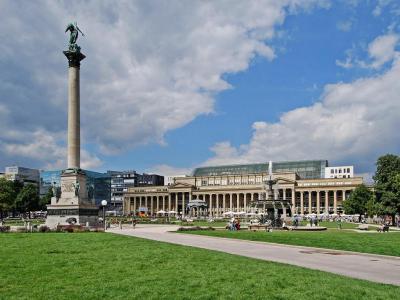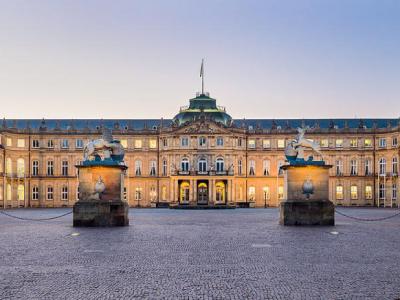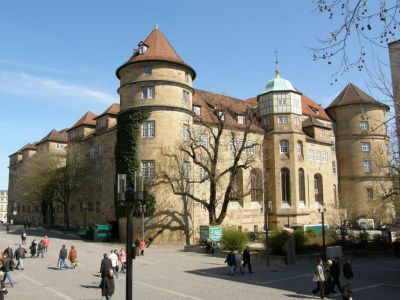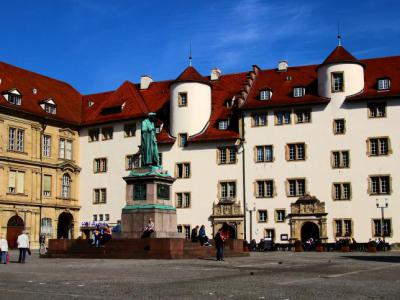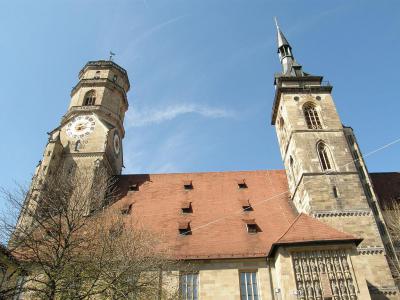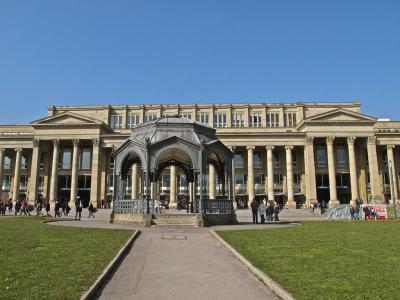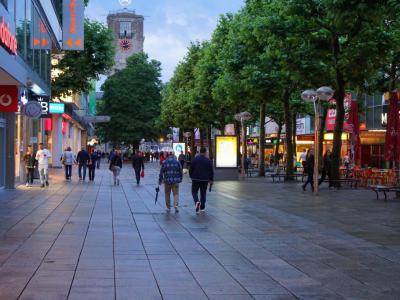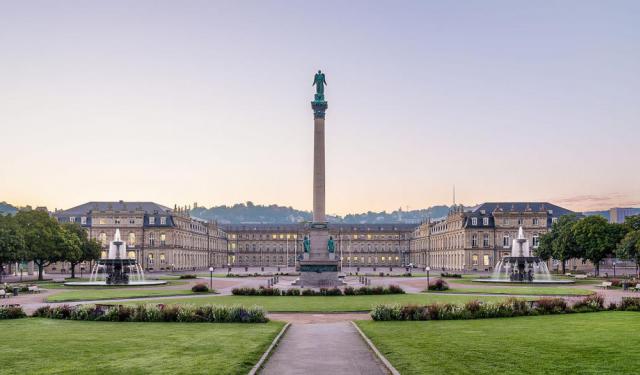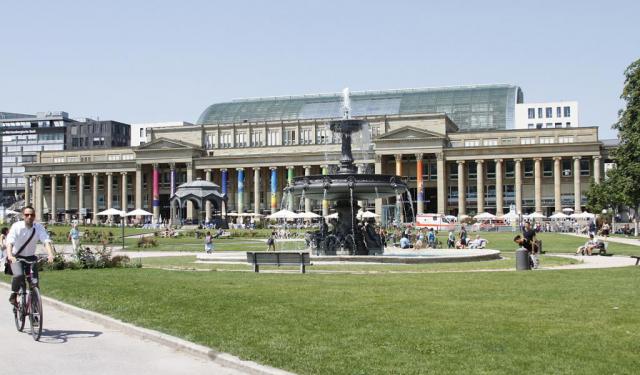
Stuttgart Introduction Walking Tour (Self Guided), Stuttgart
Stuttgart is the capital of Baden-Württemberg, a German state that is often referred to as BaWü or BW. Stuttgart has a large metropolitan area, and the city is known for its high quality of living.
The area's fertile land has attracted settlements for centuries. The Romans settled here in AD 83. During the 10th century, the Duke of Swabia used the area to breed warhorses. The town grew around this enterprise and was officially chartered in 1320.
Stuttgart was the House of Württemberg's capital from the 15th century to 1918. Many landmarks in Stuttgart were heavily damaged during World War II and have since been restored.
Stuttgart is known as the "cradle of the automobile." Resident Karl Benz invented the automobile and patented it in 1886. Gottlieb Daimler, another automobile pioneer, was based in Stuttgart.
Palace Square is home to New Castle, an imposing Baroque palace. Palace Square hosts concerts, festivals, and the famous Christmas Market.
Schiller Square is home to several historical buildings. The Collegiate Church was originally built in the 13th century. The Old Castle was originally built in the 10th century and has undergone many additions and renovations.
Shoppers will love Market Hall, which features a variety of restaurants, shops, and stalls. In addition, shoppers can find international cuisine, fresh fruit, and goods such as jewelry and books.
Shoppers can also enjoy walking King Street, a pedestrianized street lined with stores, restaurants, and cafes.
The King's Building is a stately Classical building originally designed to host concerts, balls, and conferences. The King's Passages were added to the King's Building in 2006. The new addition provides a mall-like shopping experience with a variety of shops and restaurants.
Take this self-guided walking tour to explore Stuttgart's most notable sights.
The area's fertile land has attracted settlements for centuries. The Romans settled here in AD 83. During the 10th century, the Duke of Swabia used the area to breed warhorses. The town grew around this enterprise and was officially chartered in 1320.
Stuttgart was the House of Württemberg's capital from the 15th century to 1918. Many landmarks in Stuttgart were heavily damaged during World War II and have since been restored.
Stuttgart is known as the "cradle of the automobile." Resident Karl Benz invented the automobile and patented it in 1886. Gottlieb Daimler, another automobile pioneer, was based in Stuttgart.
Palace Square is home to New Castle, an imposing Baroque palace. Palace Square hosts concerts, festivals, and the famous Christmas Market.
Schiller Square is home to several historical buildings. The Collegiate Church was originally built in the 13th century. The Old Castle was originally built in the 10th century and has undergone many additions and renovations.
Shoppers will love Market Hall, which features a variety of restaurants, shops, and stalls. In addition, shoppers can find international cuisine, fresh fruit, and goods such as jewelry and books.
Shoppers can also enjoy walking King Street, a pedestrianized street lined with stores, restaurants, and cafes.
The King's Building is a stately Classical building originally designed to host concerts, balls, and conferences. The King's Passages were added to the King's Building in 2006. The new addition provides a mall-like shopping experience with a variety of shops and restaurants.
Take this self-guided walking tour to explore Stuttgart's most notable sights.
How it works: Download the app "GPSmyCity: Walks in 1K+ Cities" from Apple App Store or Google Play Store to your mobile phone or tablet. The app turns your mobile device into a personal tour guide and its built-in GPS navigation functions guide you from one tour stop to next. The app works offline, so no data plan is needed when traveling abroad.
Stuttgart Introduction Walking Tour Map
Guide Name: Stuttgart Introduction Walking Tour
Guide Location: Germany » Stuttgart (See other walking tours in Stuttgart)
Guide Type: Self-guided Walking Tour (Sightseeing)
# of Attractions: 8
Tour Duration: 1 Hour(s)
Travel Distance: 1.7 Km or 1.1 Miles
Author: sabrina
Sight(s) Featured in This Guide:
Guide Location: Germany » Stuttgart (See other walking tours in Stuttgart)
Guide Type: Self-guided Walking Tour (Sightseeing)
# of Attractions: 8
Tour Duration: 1 Hour(s)
Travel Distance: 1.7 Km or 1.1 Miles
Author: sabrina
Sight(s) Featured in This Guide:
- Schlossplatz (Palace Square)
- Neues Schloss (New Castle)
- Altes Schloss (Old Castle)
- Schillerplatz (Schiller Square)
- Markthalle (Market Hall)
- Stiftskirche (Collegiate Church)
- Königsbau (King’s Building)
- Königstrasse (King Street)
1) Schlossplatz (Palace Square) (must see)
Palace Square is Stuttgart's largest square and home to the imposing New Castle, which dominates the square. The square was originally part of Old Castle's pleasure gardens and later served as a military parade ground from 1746-1918.
Today, the square is a focal point of the city. In 2006, the square went viral as 60,000 soccer fans waved German flags en masse during the World Cup. In addition, the city often hosts concerts and festivals in the large square. In winter, the square hosts the impressive Christmas Market.
The Jubilee Column was built in 1841 to celebrate King Wilhelm I's birthday. The column stands in the middle of the square and is 30 meters (98 feet) high. It is crowned with a five-ton bronze sculpture of the Roman goddess of harmony, Concordia. The column's substructure has bronze reliefs depicting historical events. Corner sculptures represent different attributes.
Two beautiful fountains grace the square. The fountains were built in 1863 to honor William I of Württemberg.
The square is home to the Kunstgebäude gallery, which hosts contemporary art exhibitions. The Kunstgebäude building features a dome with a golden stag.
The Upper Palace Gardens are located between the Kunstgebäude and the New Palace.
The Landtag is a dramatically different structure with a steel skeleton frame. This somber building houses parliament and was built to avoid distracting from the more ornate Opera House and State Theater.
Today, the square is a focal point of the city. In 2006, the square went viral as 60,000 soccer fans waved German flags en masse during the World Cup. In addition, the city often hosts concerts and festivals in the large square. In winter, the square hosts the impressive Christmas Market.
The Jubilee Column was built in 1841 to celebrate King Wilhelm I's birthday. The column stands in the middle of the square and is 30 meters (98 feet) high. It is crowned with a five-ton bronze sculpture of the Roman goddess of harmony, Concordia. The column's substructure has bronze reliefs depicting historical events. Corner sculptures represent different attributes.
Two beautiful fountains grace the square. The fountains were built in 1863 to honor William I of Württemberg.
The square is home to the Kunstgebäude gallery, which hosts contemporary art exhibitions. The Kunstgebäude building features a dome with a golden stag.
The Upper Palace Gardens are located between the Kunstgebäude and the New Palace.
The Landtag is a dramatically different structure with a steel skeleton frame. This somber building houses parliament and was built to avoid distracting from the more ornate Opera House and State Theater.
Sight description based on Wikipedia.
2) Neues Schloss (New Castle)
Construction on the New Castle began in 1746, and work continued until 1807. The castle was built to provide a royal residence for 16 yr old Duke Charles Eugene of Württemberg. The Duke wanted an impressive palace that would rival Versailles and threatened to move to Ludwigsburg if a suitable palace wasn't built.
Unfortunately, the construction faced many delays, including the death of the master builder and a fire during construction. As a result, the palace wasn't completed until after Duke Charles Eugene's death.
The palace is one of the last large palaces built in the area. It is mostly in Baroque style and features three main wings. Because of the lengthy construction time, the Baroque style was complemented by Rococo and Classicism styles. The facade features sculptures on the balustrades.
Duke Friedrich II became King in 1806 and redecorated the interior in the Imperial Style. The palace continued to house the kings of Wuerttemberg until King Wilhelm II abdicated in 1918. Former Federal President Richard von Weizsäcker was born in an attic apartment in the palace in 1920.
World War II bombs heavily damaged the palace, which was reconstructed from 1958 to 1964. Today the castle houses government offices.
Unfortunately, the construction faced many delays, including the death of the master builder and a fire during construction. As a result, the palace wasn't completed until after Duke Charles Eugene's death.
The palace is one of the last large palaces built in the area. It is mostly in Baroque style and features three main wings. Because of the lengthy construction time, the Baroque style was complemented by Rococo and Classicism styles. The facade features sculptures on the balustrades.
Duke Friedrich II became King in 1806 and redecorated the interior in the Imperial Style. The palace continued to house the kings of Wuerttemberg until King Wilhelm II abdicated in 1918. Former Federal President Richard von Weizsäcker was born in an attic apartment in the palace in 1920.
World War II bombs heavily damaged the palace, which was reconstructed from 1958 to 1964. Today the castle houses government offices.
3) Altes Schloss (Old Castle) (must see)
The Old Castle dates back to the 10th century. This impressive structure served as a residence for the Counts and Dukes of Württemberg. In 1325, the Dürnitz building was built. In the mid-16th century, Dukes Christoph and Louis III made various additions. The additions included an equestrian staircase, the church, and the conference room. During this renovation, the castle was redecorated and became a renaissance palace. In addition, the moat was filled during the 18th century.
The castle's arcaded courtyard features beautiful Italian Renaissance motifs. A memorial to Eberhard I stands in the inner courtyard. King Charles I of Wurttemberg is buried underneath the castle church.
A fire damaged the castle in 1931, and a World War II bomb caused further damage. Reconstruction was completed in 1962.
The Old Castle is home to a memorial exhibition commemorating Claus von Stauffenberg, a Stuttgart resident who attempted to assassinate Hitler.
The Wuerttemberg State Museum is located in the Old Castle. King Wilhelm I founded an art chamber in the 16th century, and the ducal interest in collecting priceless items continued throughout the centuries. Today, visitors can find royal diamond jewelry, the royal crown, and scepter on display. The museum portrays the area's history from the stone age to the Celts, Romans, middle ages, and more recent times.
The castle's arcaded courtyard features beautiful Italian Renaissance motifs. A memorial to Eberhard I stands in the inner courtyard. King Charles I of Wurttemberg is buried underneath the castle church.
A fire damaged the castle in 1931, and a World War II bomb caused further damage. Reconstruction was completed in 1962.
The Old Castle is home to a memorial exhibition commemorating Claus von Stauffenberg, a Stuttgart resident who attempted to assassinate Hitler.
The Wuerttemberg State Museum is located in the Old Castle. King Wilhelm I founded an art chamber in the 16th century, and the ducal interest in collecting priceless items continued throughout the centuries. Today, visitors can find royal diamond jewelry, the royal crown, and scepter on display. The museum portrays the area's history from the stone age to the Celts, Romans, middle ages, and more recent times.
4) Schillerplatz (Schiller Square)
Schillerplatz is an important square in the old city center. It was named after Freidrich Schiller, an influential German poet, historian, philosopher, and dramatist. The square was home to a brick mare house, and it is assumed that the area was used for horse breeding. The Old Castle is one of the most prominent buildings facing the square.
The square was renovated in 1594 under Duke Friedrich I's orders. The square was designed as a Renaissance Square and was paved with cobblestones. The square was then known as the "Castle and Chancellery Square." At that time, the square was part of court life. After the New Castle was built, the court moved, and the square became a part of daily civic life.
The square is home to several landmark buildings, such as the Collegiate Church, the Old Chancellory, the Old Castle, and the Prinzenbau building. The Prinzenbau was built between 1607 and 1677. Gothic style Fruchtkasten building houses musical instruments for the State Museum.
Visitors will find a memorial to Friedrich Schiller at the center of the cobblestone square. The Schiller Monument was cast from cannons and dedicated in 1839.
Schillerplatz hosts a street market twice a week. The square also hosts part of the annual Wine Village and part of the Christmas Market.
The square was renovated in 1594 under Duke Friedrich I's orders. The square was designed as a Renaissance Square and was paved with cobblestones. The square was then known as the "Castle and Chancellery Square." At that time, the square was part of court life. After the New Castle was built, the court moved, and the square became a part of daily civic life.
The square is home to several landmark buildings, such as the Collegiate Church, the Old Chancellory, the Old Castle, and the Prinzenbau building. The Prinzenbau was built between 1607 and 1677. Gothic style Fruchtkasten building houses musical instruments for the State Museum.
Visitors will find a memorial to Friedrich Schiller at the center of the cobblestone square. The Schiller Monument was cast from cannons and dedicated in 1839.
Schillerplatz hosts a street market twice a week. The square also hosts part of the annual Wine Village and part of the Christmas Market.
5) Markthalle (Market Hall)
Markets have taken place in Stuttgart since 1304, and the first market house was built in 1450. A new market hall was built in 1864, featuring modern iron and glass construction. King Wilhelm I commissioned the market to help wine growers have a place to sell their wine year-round.
However, Stuttgart soon outgrew that hall, and a larger hall was built in 1914 in the Art Nouveau style. Market Hall was constructed with reinforced concrete girders and features a glass roof.
Today, the hall is home to a variety of shops and restaurants. Visitors can shop for home and garden decor. Other shops feature books, art, jewelry, coffee, and tea. Culinary delights are a big draw, and the market is filled with fresh fruit, vegetables, meats, cheeses, spices, truffles, wine, and desserts. International foods are also on display. Visitors will find Italian, French, German, Spanish, Greek, and Arabic food available.
However, Stuttgart soon outgrew that hall, and a larger hall was built in 1914 in the Art Nouveau style. Market Hall was constructed with reinforced concrete girders and features a glass roof.
Today, the hall is home to a variety of shops and restaurants. Visitors can shop for home and garden decor. Other shops feature books, art, jewelry, coffee, and tea. Culinary delights are a big draw, and the market is filled with fresh fruit, vegetables, meats, cheeses, spices, truffles, wine, and desserts. International foods are also on display. Visitors will find Italian, French, German, Spanish, Greek, and Arabic food available.
6) Stiftskirche (Collegiate Church)
Research shows that a church has stood on this site since the 10th century. The current church was originally constructed between 1276-1293 and underwent additional construction from 1471-1493. Collegiate Church was Württemberg's first Gothic-style church.
Ulrich I, Count of Württemberg, and his wife were buried in the south chapel in 1265.
The interior contains several significant features. The baptismal font dates to 1472. Master Hanselmann created the stone pulpit in 1504. Heinrich Schickhardt designed the gorgeous carvings in the choirstalls in 1517. The church also features the oldest rose window in the region.
After the Lutheran Protestant Reformation in 1534, pictures and altars were removed from the church. Church leaders added pews and a gallery. In 1574, the church began adding statues of all the Counts of Württemberg to the chancel's north wall. A burial vault was added in 1608, and Württemberg's rulers were buried here. The Baroque onion dome replaced Gothic towers in 1749.
The church underwent renovations during the 1800s. Collegiate Church sustained damage during World War II bombs and was rebuilt in the 1950s.
Today, Collegiate Church is Württemberg's main Evangelical Luthern Chruch.
Collegiate Church is home to the Herrenberg Bell Museum. Visitors can climb the medieval spiral staircase and examine an extensive collection of bells. The museum features 30 bells whose ages span across 12 centuries.
Ulrich I, Count of Württemberg, and his wife were buried in the south chapel in 1265.
The interior contains several significant features. The baptismal font dates to 1472. Master Hanselmann created the stone pulpit in 1504. Heinrich Schickhardt designed the gorgeous carvings in the choirstalls in 1517. The church also features the oldest rose window in the region.
After the Lutheran Protestant Reformation in 1534, pictures and altars were removed from the church. Church leaders added pews and a gallery. In 1574, the church began adding statues of all the Counts of Württemberg to the chancel's north wall. A burial vault was added in 1608, and Württemberg's rulers were buried here. The Baroque onion dome replaced Gothic towers in 1749.
The church underwent renovations during the 1800s. Collegiate Church sustained damage during World War II bombs and was rebuilt in the 1950s.
Today, Collegiate Church is Württemberg's main Evangelical Luthern Chruch.
Collegiate Church is home to the Herrenberg Bell Museum. Visitors can climb the medieval spiral staircase and examine an extensive collection of bells. The museum features 30 bells whose ages span across 12 centuries.
7) Königsbau (King’s Building)
The King's Building was commissioned by King Wilhelm I and built between 1856 and 1860. The King's Building was designed as a concert hall, ballroom, and conference hall. The impressive classical-style building is 135 meters (433 feet) long. The colonnade consists of 34 columns.
The King's Building was badly damaged during World War II and was rebuilt in 1959. The building was home to the Stuttgart Stock Exchange from 1991 to 2002.
In 2006, the King's Building Passages opened. This addition features extensive retail space for offices, restaurants, and shops.
The King's Building Passages has five floors and an underground parking area. The Food Lounge has over 30 different culinary options. The shopping area features international brands, a variety of accessories, beauty products, and fashion options.
The King's Building was badly damaged during World War II and was rebuilt in 1959. The building was home to the Stuttgart Stock Exchange from 1991 to 2002.
In 2006, the King's Building Passages opened. This addition features extensive retail space for offices, restaurants, and shops.
The King's Building Passages has five floors and an underground parking area. The Food Lounge has over 30 different culinary options. The shopping area features international brands, a variety of accessories, beauty products, and fashion options.
8) Königstrasse (King Street) (must see)
King Street was established when Friedrich, the first king of Württemberg, moved his stables here during the early 19th century. King's Gate once stood at the start of the pedestrian area. The pedestrian area was designed in 1977 in anticipation of a national garden exhibition. As a result, the area was transformed with trees, fountains, and a playground.
King Street is now a busy shopping area. The street remains pedestrian only so visitors can enjoy this vibrant street without automobile traffic. The street is home to a variety of department stores, boutiques, restaurants, and cafes.
King Street is popular with locals and visitors alike. Shoppers often linger to people-watch or enjoy outdoor cafes. Don't miss the art museum with its impressive galleries.
King Street is now a busy shopping area. The street remains pedestrian only so visitors can enjoy this vibrant street without automobile traffic. The street is home to a variety of department stores, boutiques, restaurants, and cafes.
King Street is popular with locals and visitors alike. Shoppers often linger to people-watch or enjoy outdoor cafes. Don't miss the art museum with its impressive galleries.
Walking Tours in Stuttgart, Germany
Create Your Own Walk in Stuttgart
Creating your own self-guided walk in Stuttgart is easy and fun. Choose the city attractions that you want to see and a walk route map will be created just for you. You can even set your hotel as the start point of the walk.
Stuttgart's Historical Buildings
Despite being almost completely destroyed during World War II, Stuttgart boasts a wealth of quite impressive historical architecture. In the city center, carefully rebuilt after the war, you will find a mix of centuries-old castles, churches and other attractive buildings fit to impress anyone with their beauty and peculiar features.
For some serious architectural appreciation of Stuttgart,... view more
Tour Duration: 1 Hour(s)
Travel Distance: 1.3 Km or 0.8 Miles
For some serious architectural appreciation of Stuttgart,... view more
Tour Duration: 1 Hour(s)
Travel Distance: 1.3 Km or 0.8 Miles
Stuttgart Shopping Tour
When it comes to quality shopping, Stuttgart is a great destination, offering shopping enthusiasts a plethora of options to consider.
The city's main thoroughfare, King Street, colloquially known as Konigstrasse, is one of its prime shopping areas. This bustling avenue, lined with upscale boutiques and department stores, offers everything from high-end fashion to unique souvenirs.
... view more
Tour Duration: 1 Hour(s)
Travel Distance: 2.1 Km or 1.3 Miles
The city's main thoroughfare, King Street, colloquially known as Konigstrasse, is one of its prime shopping areas. This bustling avenue, lined with upscale boutiques and department stores, offers everything from high-end fashion to unique souvenirs.
... view more
Tour Duration: 1 Hour(s)
Travel Distance: 2.1 Km or 1.3 Miles
The Most Popular Cities
/ view all
